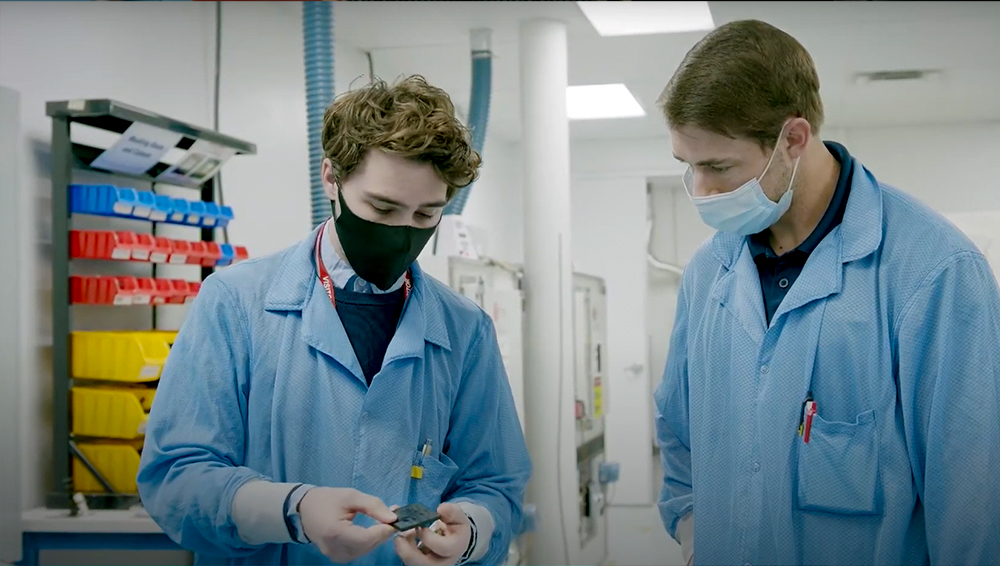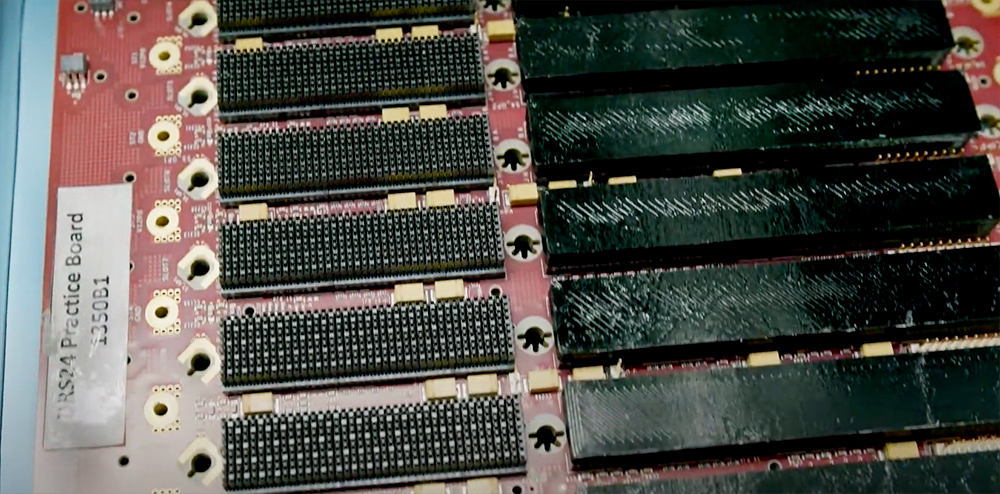Often, the smallest innovations can make the biggest impact on productivity. Take the manufacturing of printed circuit board (PCB) assemblies at tech giant Mercury Systems for example. Turnaround of the company’s mission-critical PCB technologies was hampered by a slow, expensive step in the middle of an otherwise high-tech process until a 3D printed solution changed everything.

The Conformal Coating Challenge
As a company committed to creating purpose-built solutions, every step of its manufacturing process is subject to innovative intervention. In this case, major bottlenecks in the conformal coating process for PCBs needed to be addressed. For any PCB manufacturer, conformal coating (the thin polymeric film which conforms to the contours of a printed circuit board to protect the board’s components) presents a familiar but difficult challenge.
“It is critical to prevent the conformal coating from getting into connectors in the PCB,” explains John Rolando, USMO Senior Manufacturing Engineering Manager, Mercury Systems. “In the past, we approached this in one of two ways. We either manually masked each part with tape or bought injection-molded boots from an outside provider to cover the connectors.”
Both of these methods presented unique challenges. Manually using tape was a cost-effective way to mask parts, but the time required created serious bottlenecks in the manufacturing process. Injection-molded boots allow technicians to quickly protect PCBs, eliminating labor bottlenecks, but at the cost of unsustainable lead times. On a single product order for PCBs, Mercury spent $9,000 on tooling and parts and faced a 12-week lead time.

Additive Manufacturing Solutions
To solve this issue, Mercury decided to pursue additive manufacturing technology as a solution and began exploring possible materials to match or improve on injection-molded materials. The right fit needed to be flexible, chemically resistant, and ESD-safe, a crucial property for electrostatically sensitive environments like Mercury’s. Testing quickly revealed that parts produced in TPU 74D-Z from Essentium met each requirement while significantly reducing cost and lead time.
The next step was finding the right technology. After using a desktop printer to develop prototypes, Mercury realized that the size and speed of the machine were a poor match for production needs.
Even though the desktop printer didn’t have enough production capacity, it did prove that 3D printing the boots was a viable solution for the company.
“We learned a lot about 3D printing by using the desktop printer we bought in 2020, but eventually realized we’d need a larger model to build parts in larger sizes, volume, and utilizing more robust material,” says Rolando.
The search for a production 3D printer led the company to Essentium. Although the Essentium HSE 3D Printer was significantly larger than their desktop printer, Rolando had had enough success with it to show ROI projections for the higher-capacity machine, making for quick leadership approval, he says.
In the Essentium HSE 3D Printer, Mercury found the capacity to scale its boot production and the ability to produce quality parts at a moment’s notice.
Fortunately, the desktop experienced and its similar learning curve prepared Rolando and his team for the Essentium HSE, despite it having more features and functionality than the desktop machine. “Essentium also provided prompt support for our questions and resolution on issues,” he says.
Designing PCB boots was a skill the team already possessed since they designed tools and fixtures quite a bit, but had traditionally sent them out to a vendor for production, says Rolando. “The transition to 3D printing their own designs was seamless.”

Saving 90% in Cost and Lead Time
Designing and printing in-house proved to be a winning combination for Mercury. For the same PCB product order that cost $9,000 on tooling and parts, it estimates the 3D printed equivalent was $500, reducing cost by nearly 95%.
Additionally, lead times for the injection-molded boots for this order were 12 weeks. Using the Essentium HSE, Mercury could design, iterate, and print enough boots for production use in one day, decreasing lead-time by nearly 85%.
On top of cost and lead time savings, the lifespan of these 3D printed boots is much longer. Essentium TPU 74D-Z is resistant to heat and abrasive chemicals, allowing boots to endure cycle after cycle, unlike the injection-molded boots that would degrade in under 10 cycles and have to be thrown away and replaced.
According to Mercury, using Essentium’s HSE 3D printer and ESD-safe materials for boots for any conformal coating process saves an average of 90% in cost and lead time.
“This case is just the beginning of what we can do,” says Ronaldo. “Essentium’s partnership approach has led to revelations of applications and potential opportunities that we wouldn’t have thought of.”
For example, Mercury is currently looking at an ESD-safe material solution to produce PCB holding fixtures on the Essentium HSE.
The competitive advantage 3D printing boots has brought to Mercury has garnered attention from internal business units, says Rolando.”The company is realizing that 3D printing could either be used for some of their needs and applications, or at the very least, they know that our overhead costs will be reduced by continuing to drive increased utilization on the machine.”
Lead image source: These PCB boots shown are actually injection-molded (Source: Thin Film Partners)
License: The text of "Switching from Injection Molding to 3D Printing Cut Costs 95%" by All3DP Pro is licensed under a Creative Commons Attribution 4.0 International License.